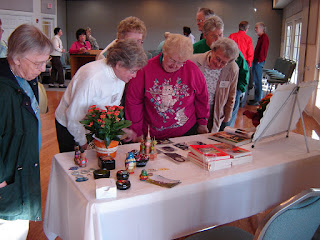 |
| Banners: For God, Tsar and Russia |
Banners: For God, Tsar and Russia was published shortly after
Ikons and covers the beginning of the First World War to the Communist Revolution. Like
Ikons,
Banners is told from several points of view: Akulina, the single mother war refugee; Sergei, Ribba and Kataya, members of the Tsar's Army; young Igor, the Bolshevik; and Massey, the immigrant torn between two countries.
 |
| Russian soldiers honoring their fallen comrades |
Just as I wove Orthodox icons throughout my first book, I used banners to tie together the story of my second. Whether it is men carrying banners into battle or women displaying pleas for bread, the Russian banner is an important part of the story. Each chapter is heralded by a quote and, as in
Ikons, is printed in the index to entice the buyer.
Banners opens where
Ikons left off. An assassination in Serbia sets off a World War and the village of Hutava sends it young men off to battle. As the war against Austria-Hungary deteriorates, Akulina and her sons are evacuated along with all the villagers from the front lines of Belarus to supposed safety of Siberia.
 |
| Cossacks burn Hutava |
 |
| Hutava villagers leaving for Siberia |
Meanwhile, Massey can only follow the horror through newsreels and newspapers. Emotions run high as immigrants' loyalties are stretched between their homeland and their new life in America. Many of the prevailing attitudes of the period were gleaned from newspaper accounts. Both archives of the Dayton Daily News and the Joliet Herald News provided a wealth of information.
 |
| Immigrant children showing loyalty to America |
Finally the Russian people and army, driven to despair by war and hunger, succumb to Bolshevik promises and form a new government. When Akulina's oldest son Stefan asks if the terror is over, she tells him it has just begun.
 |
| Russian soldiers demanding peace |
Dayton newspaper articles from that time ran dispatches from a Cox Newspaper correspondent named Sloan Gordan. I used much of his work as a Greek Chorus in relating activities along the Russian-Austrian front. His writings allowed me to place Sergei in the midst of the rout of the Russian Third Army and introduce Kataya to the Women's Shock Battalion. I read so much of his work, I was able to emulate historical reports he did not originate. I hope his spirit forgives me.
One of the more interesting articles I found while reading the old newspapers was this one from the Dayton Evening News citing the London Times:
Figures Say War Will End Nov. 11
Paris, July 18 To the
Paris Pigate one of its readers had contributed a rather original
prognostication in regard to the duration of the present war. The prophecy,
which is based on a play with figures, reads like this:
Take the figures of the two years covering the last war with
Germany and add them up this way:
1870
1871
------
3741
Of the sum obtained, the first two figures, 3 and 7, make
together 10, while the last two, 4 and 1 make 5. The treaty of peace was signed in Frankfort
on the Main on the tenth day of the fifth month, that is May 10. 1871.
Apply the same method to the war now going on. We then get:
1914
1915
----
3829
Adding 3 and 8 gives 11, and 2 and 9 also make 11. Consequently, reasons this mathematical
soothsayer, the great war will come to an end on the eleventh day of the
eleventh month, or November 11, of the present year.
Not a bad prediction. The only problem was the present year in this case was 1915, not 1918.

















